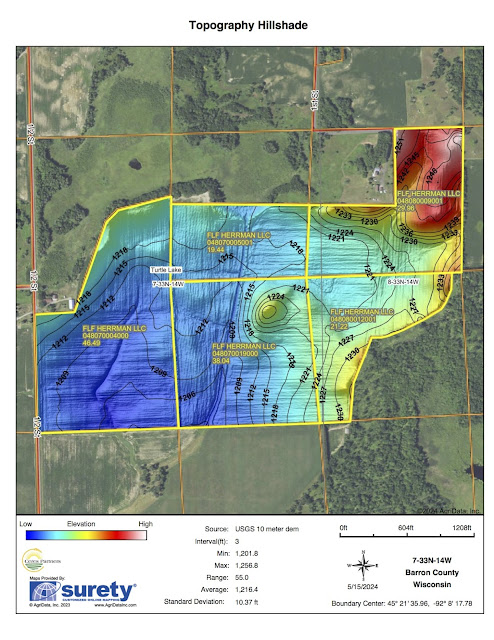We were late getting this crop in, caused mainly by problems getting our State permit to spread turkey litter followed by untimely rains which made it impossible to do field work. The delay, while not ideal, is not a fatal problem. Oats do best when they can set full heads of grain before the hottest part of the summer - meaning that they need to be planted early for optimum results. That said, all 145 acres (60 ha) that we are transitioning to organic production (a 36 month process) are now planted.
One of the three fields, seen below on the right hand side of a photo I took of the monitor screen in the cab, has a lot of wet spots.
(click on any picture to make it bigger)
We would like to have drain tile installed to help dry up some of the wet (showing up in the above image as white places) spots. A topographical map (below) shows that the most likely route is south, crossing the neighbors property a short distance, before ending up in a drainage ditch that passes through a small cluster of trees on the neighbors land.
 |
| The piece we own is the western most parcel, colored in blue. |
In the meantime, the oats will be harvested then the red clover will continue growing, overwintering and then returning next year. The clover will be mowed with the residue remaining on top of the soil, feeding microbes. There is the chance that I will try to harvest some of the clover seed in the fall of 2025. The following year, 2026, will be organic corn.
To give you some idea about the scale of this, we planted about 14,000 lbs (6300 kg) of oats and 1400 lbs (630 kg) of medium red clover on 145 acres (60 ha) over 3 days. The average historical yield for this variety of oats is 100 bushels, or 3200 lbs, per acre (3600 kg/ha). If all goes well, by the end of July we'll harvest about 460,000 lbs (210,000 kg) of food grade conventional oats. I'm still trying to find a buyer for food grade oats. I can always sell them as animal feed, but the price is about half.
While these numbers are big, the reality is that we are a smallish farm, at least by the standards in the midwestern US.

good teachings, thank you Brother!!
ReplyDelete